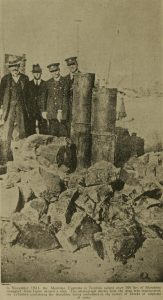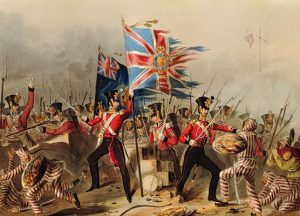Below is a detailed article on the Opium Wars that were fought between China and Britain and Britain and France against China.

The first Opium Wars was fought in the years between 1839 – 1842. The second war was fought during 1856 – 1860.
What is Opium?
Opium is a heavily scented addictive drug which is illegally used as a narcotic. It is often used in medicines as an analgesic. It is made from the juice of the opium poppy.
It is processed further using chemicals and is turned into ‘heroin’, a deadly drug and other opioids for medical or illegal consumption.

In ancient times, it was used as the most powerful form of pain relief in medical surgeries and prolonged medical operations. The movement of this drug started around the 11th Century AD.
The First Opium Wars
The war was between the British and the Chinese during 1839 – 1842. In the early 18th century, when the British started colonialism in India. They started exporting opium from India to China. There was a substantial growth in the export of opium in the year 1820.
As a result, there was an increase in the addiction of people to this drug and this disrupted the social lives of the people, destroying many families and households. The Government of China started the confiscation of opium in the year 1839 as a consequence of the result of the overuse of opium by the people.

More than 20000 chests of opium and 1400 tons of other drugs were found and destroyed. These drugs were found in the warehouses of the British merchants in Canton (present-day Guangzhou). In the same year, more and more chaos began to occur.
It reached its peak when some British merchants that were drunk killed a Chinese man. The British merchants refused to present themselves in the Chinese courts or accept any kind of punishment.
First Opium War Facts
Again, some British warships destroyed the Chinese barricades and broke into the Pearl River estuary in Hong Kong and destroyed it. In May 1841, the British captured the same city after months of bringing in more manpower, negotiating and finally attacking the Chinese officials.
In 1842, some Chinese troops attacked the British because of which the British captured Nanking in the month of August. Finally, the fighting came to an end.
Settlement of the First Opium War
The Chinese and the British worked out a peace negotiation as soon as the same month as the very year of 1842. It was called the ‘Treaty of Nanking’. According to this treaty, China was liable to pay the British a heavy compensation or restitution of the war.

They were to increase the number of Treaty Ports or ports that were open to foreign trade, dominantly the Western countries. From one treaty port, it became five. Accommodation for the British merchants was also to be provided.
Opium War in China
Shanghai, one of the major ports in China was also added to the Treaty Ports. Another treaty was signed on the 23rd of October, 1843. This was the Brtish Supplementary Treaty of the Bogue.

According to this treaty, the British gained ‘extraterritoriality’ which is the state of being exempt from the jurisdiction of the local law. Due to this law, the Chinese Government held no power over the British Merchants in certain aspects of the trade.
Imitating the British, other countries also demanded the same and were granted extraterritoriality.
The Second Opium War
The Second Opium Wars were fought by the British and French against the Chinese. This war took place between 1856 – 1860.
The Qing government that belonged to the kingship of the Qing Dynasty was deeply involved in putting an end to the rebellion of Taiping that started in 1850 and went on until 1864. The British took advantage of their situation started their conflicts regarding seeking the right to extend trade in China.

In October 1856, some Chinese officials boarded the British registered ship called “Arrow” and arrested some Chinese crew members. They lowered the British Flag that was hoisted on top of the Arrow.
This rose rebellion among the British bombarded the River Pearl Estuary in Canton. All existing trade activities came to be ceased. In the year 1856, a French missionary was murdered in China.
The British used this excuse and included the French Government in its war with China. The Chinese were weak in assembling troops and had fewer resources compared to the British and the French combined. Thus, the city of Canton was captured.

The Chinese governor of the city was laid off and instead a British official was installed. Again, in 1858, the British troops entered Tianjin and yet again tried to make trade negotiations with the Chinese forcing them to do so.
Settlements of the Second Opium War
The Treaty of Tianjin was signed in June 1858. According to the treaty, the British official received accommodations in Beijing, the opening of new ports for more foreign, mostly Western Trade, and freedom of movement and the right to travel anywhere in the interior of China for Christian missionaries.

Later, with more negotiations and further persuasions, the Chinese Government legalized the trade of Opium with respect to import.
In the summer of the same year, the British withdrew from Tianjin treaty and went back to England. However, at their return in 1859, they were driven back to England with heavy casualties at the Dagu shore in Hai River.
Second Opium War Facts
In 1860, the British returned along with the French troops and destroyed the Dagu shore and captured Beijing. They destroyed the Yuanming Garden which was the emperor’s summer palace. Later, at the Beijing Convention, the Treaty of Tianjin of 1858 was restored.

The Opium Wars caused too many destructions in many cities in China. Not only were the cities exploited in a commercial way but the societies were also being destroyed due to easy access to the deadly drug – Opium. It was being consumed by young men from the age of 15 to 40.
They had become addicts and their recovery was nearly impossible. Many houses and farms were destroyed during the second Opium War. Not only that, ships and the docks were also destroyed in large number.
More Info On- Victorian Era Military, weapons of the Victorian era